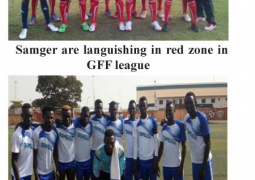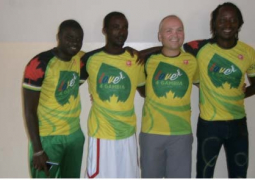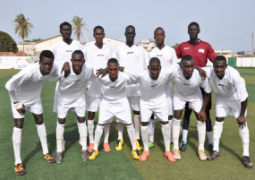As
we continue to write about jazz, we always try to remind our readers about the
link that exist between the melodious sounds of Africa and the jazz idiom that
was developed in the United States.
We
have traced the origins of jazz to Africa, but it was not called jazz then, and
the term jazz only came into existence after the music developed in New
Orleans.
The
pioneers of the music later moved to Chicago where the word was used to
describe the music and the dance. Yes! The dance. Jazz, just like the foxtrot
is a revere form of dance that is smooth and artistic.
As
the jazz movement grew and developed, several sub-genres of jazz evolved and
became part of the movement. One of those sub-genres that appeared is what is
usually referred to as “Soul Jazz”.
Soul
Jazz is a development of jazz incorporating strong influence from the blues,
soul, gospel and rhythm and blues. It received mainstream popularity during the
50’s and 70’s and is often associated with hard bop. In fact it has been
referred to as an outgrowth of hard bop, and is described as music with “an earthy
bluesy melodic concept with repetitive dance like rhythm”.
The
term “funk” and “soul” appeared in the jazz scene as early as the 50’s and was
greatly influenced by the music of Ray Charles, Cannonball Adderly, Horace
Silver, Art Blakey and Hank Crawford. It should be noted however, that some
people make no distinction between soul jazz and funky hard bop.
Our
feature this week is on someone with strong roots to Africa and also someone
whose music has been very influential and contributory to what is known as hard
bop and soul jazz.
His
birth name is Horace Ward Martin Tavares Silva. He was born in Norwalk,
Connecticut on September 2nd 1928 and is known as an American jazz pianist and
composer.
His
father, John Tavares Silva was from the Island of Maio in Cape Verde, West
Africa, and his mother was of Irish-American descent born in New Canaan,
Connecticut.
They
are from the African-American group referred to as Cape Verdean, and are
commonly found in Connecticut and Massachusetts especially in the area called
Martha’s Vineyard. In the Gambia, we refer to them as Mulatos (malatarr).
Horace
began his musical career as a tenor saxophonist but later switched to the
piano. His early musical career was greatly influenced by saxophonist Lester
Young and pianist Bud Powell. In 1951 he was fortunate to meet saxophonist Stan
Getz while playing at the Sundown Club in Hartford, Connecticut. Stan liked
what he saw and heard and went on to invite Horace and his band to tour with
him. It was with Getz that he made his recording debut.
In 1951, Horace moved to New York where he
worked at the jazz club-Birdland- on Monday nights, which was a night when
different musicians would come together and jam informally.
It
was at this club where he would meet the executives of Blue Note Records who
eventually signed him on a recording contract that lasted until 1980.
It
was also in New York where he formed the Jazz Messengers which became
co-operatively run by him and Art Blakey.
Between 1952 and 53, Horace recorded three sessions with his own trio,
featuring Art Blakey on drums and Gene Ramey, Curly Russell and Percy Heath on
bass; his association with Blakley lasted for several years, and during this
period they recorded a live album-(A Night at Birdland Vol. 1) with Russell,
Clifford Brown and Lou Donaldson. They also recorded at the Bohemia Club with
Kenny Dorham and Hank Mobley.
Silva
was also a member of the Miles Davis All Stars and was involved in the
recording of the album “Walkin” in 1954. From 1956 onwards, Silva recorded
exclusively for the Blue Note Label and became close friends with the label’s
executive.
He
was given a lot of latitude and allowed greater input on aspects of album
production, which paved the way for him to create that branch of jazz known as
‘hard bop’.
Some
of his key albums from this period include-the Horace Silva Trio (1953), Horace
Silva and the Jazz Messengers (1955), 6 Pieces of Silva (1956) and Blowin’ the
Blues Away (1959).
Silva
who did not want to play up the fact that he was proficient in Portuguese and
had a rich lusophone musical upbringing, recorded the album “Cape Verdean Blues”
in 1965. Earlier, in 1964 he recorded the song “Song for My Father”, which was
a reflection of his childhood days when his father and uncle would have musical
parties where they would dance to African rhythms while playing three or four
stringed musical instruments. After his tour of Brazil in 1964, he began
melding additional lusophone influences into his music. He was also greatly
influenced by Art Tatum, Teddy Wilson, Nat “King” Cole and Thelonius Monk.
In
1963 Silva created a new group featuring Joe Henderson on tenor saxophone and
Carmell Jones on trumpet. It was with this group that he recorded his best
known album-Song for My Father.
His
compositions which became increasingly catchy and very strong harmonically,
gained popularity and his band gradually switched to funk and soul. After his
long tenure with Blue Note ended, he continued to create vital music and in
2005, he was awarded the President’s Merit Award from the National Academy of
Recording Arts and Science.
Horace
has been a major force in modern music and was one of the pioneers of hard-bop,
influencing pianist such as Les McCann, Ramsey Lewis and Bobby Timmons.
His
unique arrangement of musicians into a quintet with a trumpet, saxophone,
piano, double bass and drums also served as a model for small jazz groups from
the mid 50’s to the 60’s.
Horace
Silva is still living happily in California surrounded by a devoted family.
Jazz
education for Jazz appreciation. We dedicate this little piece in loving memory
of Mr. Abdou Karim Savage (A. K. Savage) former Chief Justice of the Gambia.
He
inspired us to appreciate the value of scholarship and the culture of reading.
He was truly a gentleman and a scholar.




